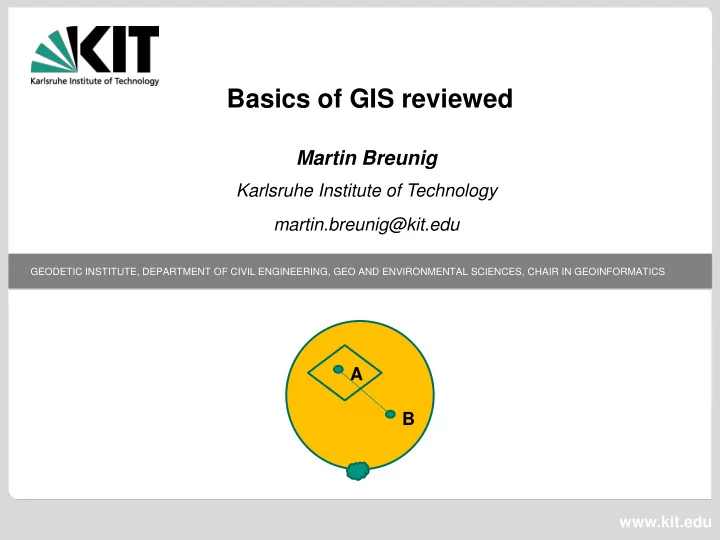

Basics of GIS reviewed Martin Breunig Karlsruhe Institute of Technology martin.breunig@kit.edu GEODETIC INSTITUTE, DEPARTMENT OF CIVIL ENGINEERING, GEO AND ENVIRONMENTAL SCIENCES, CHAIR IN GEOINFORMATICS A B www.kit.edu
Different views on GIS Companies/ Geo-spatial applications Private persons GIS Authorities Research / Universities Geo-spatial teaching planning Adapted from: R. Bill, Basics of GIS (in German) 2
From „GIS“ to „GIS“ since 1963 GIS: (Roger Tomlinson, Canada) „ G eographical I nformation S ystem“ since 1992 (Michael Goodchild, USA) GIS: „ G eographical I nformation S cience“ since 1990 „ Spatial Information Science“ (Goodchild, USA) 3
Geoinformation Science Acquisition and modeling of geo-objects (semantics, geometry, topology) Uncertainty of Geoinformation WebGIS Management, visualization and Mobile GIS analysis of Geosensor networks geoinformation … 2D/3D/4D GIS Navigation systems 3D city- and sub-surface models Early warning systems against natural hazards 4
Geoinformation Science Geodesy/ Geology ... Geography Geophysics Environmental Cartography Geoinformation Science Computer Science Databases/ Programming ComputerGraphics/ Software- ... Networks/ WWW languages geom. algorithms Engineering 5
GIS workflow Geo-data acquisition Geo-data modeling Geo-data management Geo-data analysis Geo-data visualization 6
„ Centre “ of GIS "The common element of all GIS applications in various disciplines is the spatial reference. This arises depending on the question of the user, however, is very different. ... “ (Ralf Bill, in German) 7
„ Centre “ of GIS: Spatial reference "... In surveying the (direct) spatial reference is given by specifying two or three dimensional coordinates or equivalent design requirements, where a defined reference system and a primary metric is defined. Furthermore, these data include information as to their accuracy or uncertainty relations. ... " (Ralf Bill, in German) 8
Geoinformation " Geoinformation can be considered as a resource (land, labour, capital). But it is also a commodity that can be bought and sold. It provides for a nation a similar infrastructure as the transport network or healthcare. Without this infrastructure, the social system would not work. Geographic Information is a commodity which deployed, managed and must be kept up to date. ... " (Ralf Bill, in German) 9
Geo-data Geo-data “are information about objects, terrain and infrastructure at the surface, with a spatial reference as an essential element. They describe the individual features of the landscape. Spatial data can be linked to each other via the spatial reference, so new information can be derived in particular with the use of GIS functionalities. ... " (Ralf Bill, in German) On and with geo-data, queries, analyzes and evaluations for certain issues can be executed. 10
Geo-data We can distinguish between the following geo-data: Nature describing geo-data Geo-data that describe natural states and processes on the Earth's surface, such as the results of human planning, hydrological, geological, atmospheric, geological data Artefact describing geo-data Geo-data that describe demographic, geography and transportation, economic and market conditions 11
An example for nature descriptive data DTM – Digital terrain model "DTM describes the digital representation of the terrain surface by spatial coordinate triple of a set of surface points (vertices), eg in the form of triangle meshes or grids. DTM is a database for the elevational description of the site. ... " „2.5D“ : h = f(x, y) Source (in German): Ralf Bill http://www.geoinformatik.uni-rostock.de/einzel.asp?ID=984408921 12
„ Closing the circle “: Back to GIS – Geographical Information System “A Geographical Information System is a computer-based system that consists of hardware, software, data and applications. With it geospatial data can be digitally recorded and edited, stored and reorganized, modeled, analyzed and presented in alphanumeric and graphic. ... “ Quelle: Ralf Bill http://www.geoinformatik.uni-rostock.de/einzel.asp?ID=984408921 13
System architectures for GIS Layers of a GIS architecture: GIS User Interface (GUI) GIS-Tools (Analysis) Data handling component 14
Everyday life Everyday life Everyday life Everyday life Everyday life Everyday life Everyday life Everyday life Everyday life Everyday life Everyday life Everyday life Everyday life Everyday life Everyday life Visions? Everyday life Everyday life Everyday life Everyday life Everyday life Everyday life Everyday life Everyday life Everyday life Everyday life Everyday life Everyday life Everyday life Everyday life Everyday life 15
… Collaborating in innovative projects … … … of GeoInformation Science 16
Recommend
More recommend